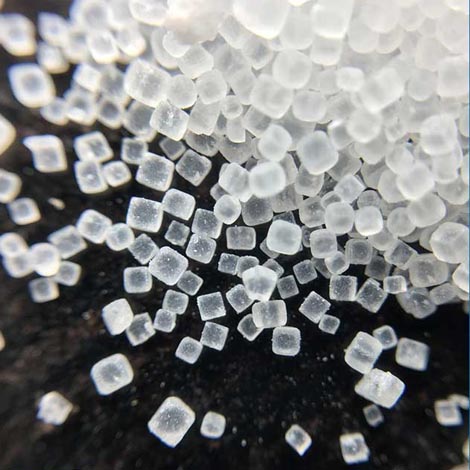SiO2 has a number of distinct crystalline forms (polymorphs) in addition to amorphous forms. With the exception of stishovite and fibrous silica, all of the crystalline forms involve tetrahedral SiO4 units linked together by shared vertices. Silicon–oxygen bond lengths vary between the various crystal forms; for example in α-quartz the bond length is 161 pm, whereas in α-tridymite it is in the range 154–171 pm. The Si-O-Si angle also varies between a low value of 140° in α-tridymite, up to 180° in β-tridymite. In α-quartz, the Si-O-Si angle is 144°.
Fibrous silica has a structure similar to that of SiS2 with chains of edge-sharing SiO4 tetrahedra. Stishovite, the higher-pressure form, in contrast, has a rutile-like structure where silicon is 6-coordinate. The density of stishovite is 4.287 g/cm3, which compares to α-quartz, the densest of the low-pressure forms, which has a density of 2.648 g/cm3. The difference in density can be ascribed to the increase in coordination as the six shortest Si-O bond lengths in stishovite (four Si-O bond lengths of 176 pm and two others of 181 pm) are greater than the Si-O bond length (161 pm) in α-quartz. The change in the coordination increases the ionicity of the Si-O bond. More importantly, any deviations from these standard parameters constitute microstructural differences or variations, which represent an approach to an amorphous, vitreous, or glassy solid.
The only stable form under normal conditions is alpha quartz, in which crystalline silicon dioxide is usually encountered. In nature, impurities in crystalline α-quartz can give rise to colors (see list). The high-temperature minerals, cristobalite and tridymite, have both lower densities and indices of refraction than quartz. Since the composition is identical, the reason for the discrepancies must be in the increased spacing in the high-temperature minerals. As is common with many substances, the higher the temperature, the farther apart the atoms are, due to the increased vibration energy.
The transformation from α-quartz to beta-quartz takes place abruptly at 573 °C. Since the transformation is accompanied by a significant change in volume, it can easily induce fracturing of ceramics or rocks passing through this temperature limit.
The high-pressure minerals, seifertite, stishovite, and coesite, though, have higher densities and indices of refraction than quartz. This is probably due to the intense compression of the atoms occurring during their formation, resulting in more condensed structure.
Faujasite silica is another form of crystalline silica. It is obtained by dealumination of a low-sodium, ultra-stable Y zeolite with combined acid and thermal treatment. The resulting product contains over 99% silica, and has high crystallinity and surface area (over 800 m2/g). Faujasite-silica has very high thermal and acid stability. For example, it maintains a high degree of long-range molecular order or crystallinity even after boiling in concentrated hydrochloric acid.
Molten silica exhibits several peculiar physical characteristics that are similar to those observed in liquid water: negative temperature expansion, density maximum at temperatures ~5000 °C, and a heat capacity minimum. Its density decreases from 2.08 g/cm3 at 1950 °C to 2.03 g/cm3 at 2200 °C.
Molecular SiO2 with a linear structure is produced when molecular silicon monoxide, SiO, is condensed in an argon matrix cooled with helium along with oxygen atoms generated by microwave discharge. Dimeric silicon dioxide, (SiO2)2 has been prepared by reacting O2 with matrix isolated dimeric silicon monoxide, (Si2O2). In dimeric silicon dioxide there are two oxygen atoms bridging between the silicon atoms with an Si-O-Si angle of 94° and bond length of 164.6 pm and the terminal Si-O bond length is 150.2 pm. The Si-O bond length is 148.3 pm, which compares with the length of 161 pm in α-quartz. The bond energy is estimated at 621.7 kJ/mol

















Reviews
There are no reviews yet.